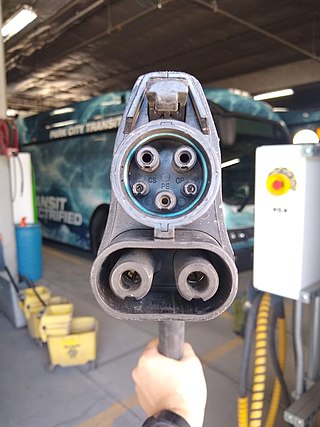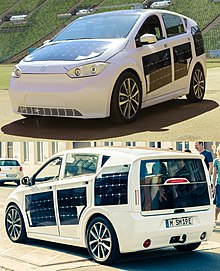
An electric vehicle (EV) is a vehicle that uses one or more electric motors for propulsion. It can be powered by a collector system, with electricity from extravehicular sources, or it can be powered autonomously by a battery. EVs include but are not limited to road and rail vehicles, and broadly can also include electric boat and underwater vessels, electric aircraft and electric spacecraft.

An automotive battery, or car battery, is a rechargeable battery that is used to start a motor vehicle. Its main purpose is to provide an electric current to the electric-powered starting motor, which in turn starts the chemically-powered internal combustion engine that actually propels the vehicle. Once the engine is running, power for the car's electrical systems is still supplied by the battery, with the alternator charging the battery as demands increase or decrease.

A solar vehicle or solar electric vehicle is an electric vehicle powered completely or significantly by direct solar energy. Usually, photovoltaic (PV) cells contained in solar panels convert the sun's energy directly into electric energy.

Valmet Automotive is a Finnish vehicle contract manufacturer and supplier of battery, roof, and kinematic systems.

A charging station, also known as a charge point or electric vehicle supply equipment (EVSE), is a power supply device that supplies electrical power for recharging plug-in electric vehicles.

A solar car is a solar vehicle for use on public roads or race tracks. Solar vehicles are electric vehicles that use self-contained solar cells to provide full or partial power to the vehicle via sunlight. Solar vehicles typically contain a rechargeable battery to help regulate and store the energy from the solar cells and from regenerative braking. Some solar cars can be plugged into external power sources to supplement the power of sunlight used to charge their battery.

The Fisker Karma is a luxury plug-in range-extended electric sports sedan produced by Fisker Automotive in 2012. The cars were manufactured at Valmet Automotive in Finland.

An electric car or electric vehicle (EV) is a passenger automobile that is propelled by an electric traction motor, using only energy stored in on-board batteries. Compared to conventional internal combustion engine (ICE) vehicles, electric cars are quieter, more responsive, have superior energy conversion efficiency and no exhaust emissions and lower overall vehicle emissions. The term "electric car" normally refers to plug-in electric vehicle, typically a battery electric vehicle (BEV), but broadly may also include plug-in hybrid electric vehicle (PHEV), range-extended electric vehicle (REEV) and fuel cell electric vehicle (FCEV).

A battery electric vehicle (BEV), pure electric vehicle, only-electric vehicle, fully electric vehicle or all-electric vehicle is a type of electric vehicle (EV) that exclusively uses chemical energy stored in rechargeable battery packs, with no secondary source of propulsion. BEVs use electric motors and motor controllers instead of internal combustion engines (ICEs) for propulsion. They derive all power from battery packs and thus have no internal combustion engine, fuel cell, or fuel tank. BEVs include – but are not limited to – motorcycles, bicycles, scooters, skateboards, railcars, watercraft, forklifts, buses, trucks, and cars.
NEVS AB was a Swedish electric car manufacturer which acquired the assets of Saab Automobile from a bankruptcy estate in 2012. After facing numerous financial difficulties, the company was closed in March 2023, with both Polestar and EV Electra interested in buying the former Trollhättan factory.

Tesla Supercharger is an electric vehicle DC fast-charging network built by American vehicle manufacturer Tesla, Inc.

The Combined Charging System (CCS) is a standard for charging electric vehicles. It can use Combo 1 (CCS1) or Combo 2 (CCS2) connectors to provide power at up to 350 kilowatts (kW) . These two connectors are extensions of the IEC 62196 Type 1 and Type 2 connectors, with two additional direct current (DC) contacts to allow high-power DC fast charging. In response to demand for faster charging, 400 kW CCS chargers have been deployed by charging networks and 700 kW CCS chargers have been demonstrated.

The IEC 62196 Type 2 connector is used for charging electric vehicles, mainly within Europe, as it was declared standard by the EU. Based on widespread red IEC 60309 three phase plugs with five pins, which come in different diameters according to maximum current, a single size was selected, as maximum possible power will be communicated to the car via two additional communication pins and by a simple resistor coding within the cable. The onboard charger inside the car has to limit the current accordingly.
The electric vehicle industry in India is slowly growing. The central and state governments have implemented schemes and incentives to promote electric mobility, and have introduced regulations and standards. Although India would benefit from converting its transport from internal combustion (IC) engines to electric motors, challenges include a lack of charging infrastructure, high initial cost and a lack of renewable energy. E-commerce companies, car manufacturers, app-based transport network companies and mobility-solution providers have entered the sector, however, and are slowly building electric-car capacity and visibility.

The Karma Revero is a luxury plug-in hybrid sports sedan manufactured in the United States by Chinese-owned Karma Automotive. It is a revamped version of the Fisker Karma car. The first of the new production, for model year 2017, was released in September 2016.
Fisker Inc. is an American automotive company founded by Danish automotive designer Henrik Fisker and his wife Geeta Gupta-Fisker. Launched in 2016 and based in Manhattan Beach, California, Fisker Inc. is the successor to Fisker Automotive.
Contemporary Amperex Technology Co. Limited, abbreviated as CATL, is a Chinese battery manufacturer and technology company founded in 2011 that specializes in the manufacturing of lithium-ion batteries for electric vehicles and energy storage systems, as well as battery management systems (BMS). In 2022, its global market share stood at 37%.

Sonnenwagen Aachen is a current project by students from RWTH Aachen University and FH Aachen for the development and construction of a solar car, to participate in the World Solar Challenge in Australia. The solar car race with a length of 3022 km from Darwin in Northern Territory to Adelaide in South Australia is known to be the longest solar car race in the world and has celebrated its 30th anniversary in October 2017.
Sono Motors GmbH is a German company working on the development of the electric solar car Sono Sion. A special feature of the vehicle designed by the company is solar cells embedded in the plastic body panels on both the roof and the sides. The electricity generated is fed into the traction battery and is said to be sufficient as an energy source for more than 5,000 kilometers per year. Sono Motors has been licensing this technology for use in buses and trucks since 2021.


















